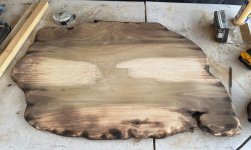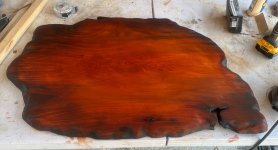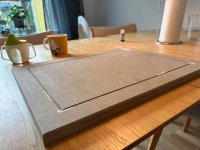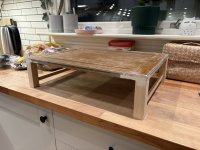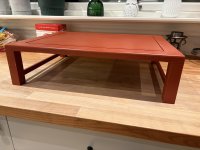You are using an out of date browser. It may not display this or other websites correctly.
You should upgrade or use an alternative browser.
You should upgrade or use an alternative browser.
Building a table
- Thread starter Berra
- Start date
RozendaalArts
Mame
Nice work! I've been meaning to try it too, this is encouraging
Mamber
Seedling
As a bit of a woodwork hobbyist myself I love this thread, and the end result there is very good!
(My partner will be annoyed I now have more ideas!)
(My partner will be annoyed I now have more ideas!)
Cap'n Paul
Seed
- Messages
- 4
- Reaction score
- 6
Nicely done.
Attmos
Chumono
Very nice.
Poplar is a tough one. It's actually considered a hardwood, but it stains like a softwood. A few (yes, more than one) coats of pre-stain should eliminate the oils is the wood. More applications depending on how new the wood is.
Nice work, it ain't easy. Also, I like the burned edges... cool.
Poplar is a tough one. It's actually considered a hardwood, but it stains like a softwood. A few (yes, more than one) coats of pre-stain should eliminate the oils is the wood. More applications depending on how new the wood is.
Nice work, it ain't easy. Also, I like the burned edges... cool.
Bonsai Nut
Nuttier than your average Nut
Interestingly, poplar is neither a hardwood nor a softwood. Some call it a "mid-wood" because it is an angiosperm (hardwood) with very light wood that falls below many conifers on the hardness scale (softwood). Even crazier is that if you are talking Tulip poplar (the tallest tree east of the Mississippi and the source of most "poplar" lumber) it isn't even a true poplar - it is in the magnolia familyI find the best thing to use on soft woods is an alcohol based dye.
This is dyed poplar. Regular stain would turn out splotchy and ugly.
Great job on that stand btw, I’ve made a couple and they aren’t easy!
That said (I love wood arguments) I am of the opinion that when finishing, you finish poplar like a hardwood, not a softwood, due to the low sap content of the wood. I have not experienced the splotchiness you refer to.
stewarjm192
Mame
Stand maker here, just back from vending at the Nattonal. Stand looks great, but a word of advice in your construction. That center panel and groove around it are not strictly for aesthetic. The center panel should “float” in your picture frame boarder. This allows for expansion and contraction of the wood with different relative humidity levels. Without this “float”, and with your frame glued directly to the edges of your center panel, the woods expansion will put a lot of internal pressure on your glued miter corners. Those joints are very weak as they are end grain to end grain, and will break from the pressure of an expanding center panel. I made my first few stands like yours and some failed just as I describe. You should also consider reinforcing the miter with a sole of some kind, in addition to the floating center!
Hey Thanks! Didnt consider this obviously. So the center panel should not be fastened at all then? In other words, can you lift it off and replace it with your stands?Stand maker here, just back from vending at the Nattonal. Stand looks great, but a word of advice in your construction. That center panel and groove around it are not strictly for aesthetic. The center panel should “float” in your picture frame boarder. This allows for expansion and contraction of the wood with different relative humidity levels. Without this “float”, and with your frame glued directly to the edges of your center panel, the woods expansion will put a lot of internal pressure on your glued miter corners. Those joints are very weak as they are end grain to end grain, and will break from the pressure of an expanding center panel. I made my first few stands like yours and some failed just as I describe. You should also consider reinforcing the miter with a sole of some kind, in addition to the floating center!
Shibui
Imperial Masterpiece
The centre panel is usually trapped in grooves of some sort - so it cannot come out but is still free to expand and contract as humidity changes.
For very small panels this is less important as the differential expansion is so small. The bigger the centre panel is, the more important an expansion joint becomes.
I also add decorative splines which help reinforce the mitre joints at each corner.
@Berra Would it be OK if @stewarjm192 added some photos of the stands he makes to this thread. We obviously did not get to the show to see his work there.
For very small panels this is less important as the differential expansion is so small. The bigger the centre panel is, the more important an expansion joint becomes.
I also add decorative splines which help reinforce the mitre joints at each corner.
@Berra Would it be OK if @stewarjm192 added some photos of the stands he makes to this thread. We obviously did not get to the show to see his work there.
I see, more tools will be needed thenThe centre panel is usually trapped in grooves of some sort - so it cannot come out but is still free to expand and contract as humidity changes.
For very small panels this is less important as the differential expansion is so small. The bigger the centre panel is, the more important an expansion joint becomes.
I also add decorative splines which help reinforce the mitre joints at each corner.
@Berra Would it be OK if @stewarjm192 added some photos of the stands he makes to this thread. We obviously did not get to the show to see his work there.
Yes sure, I don’t plan on expanding this thread more anyway
stewarjm192
Mame
Tools are a router table and a few bits. A slot cutter for your outer pieces, and a rabitting set to cut the rabbit around the center panel. Reinforcing the miter is another story and can be done a number of ways I do mine on the router table with a 1/8th bit, but will probably move to a table saw jig when I have the time to do itI see, more tools will be needed then
Yes sure, I don’t plan on expanding this thread more anyway
I’ll post some photos when I can figure out how to downsize the files on my phone, BNut website always says files too large
stewarjm192
Mame
This is correct. And usually, I will “pin” the panel in a few spots to hold it in place and prevent it from shifting around freely. Wood generally moves most across the grain, rather than along it, so you can pin the panels in the groove of your picture frame with a drop or two of glue on the panels end grain, allowing the side a of the panel to expand, but holding the panel in placeThe centre panel is usually trapped in grooves of some sort - so it cannot come out but is still free to expand and contract as humidity changes.
For very small panels this is less important as the differential expansion is so small. The bigger the centre panel is, the more important an expansion joint becomes.
I also add decorative splines which help reinforce the mitre joints at each corner.
@Berra Would it be OK if @stewarjm192 added some photos of the stands he makes to this thread. We obviously did not get to the show to see his work there.
with so nice first outcome? i doubtJust one… more… table… I can quit this new hobby when I want
This was hard, I wanted to achieve a glossy surface. primer and top coat applied in layers on top of each other until I gave up and sanded the final layer of top coat down.
I should have been more careful perfecting the surface before applying top coat.
I should have been more careful perfecting the surface before applying top coat.
Attachments
But, I know that from a matte surface, it is possible to sand it with gradually finer sand paper. And then one can polish it.
I think while I did not achieve perfect ’expensive black piano style’ finish it is OK for a less than $40 all in all material budget.
I think while I did not achieve perfect ’expensive black piano style’ finish it is OK for a less than $40 all in all material budget.
Attachments
To have the table legs be placed flush to the table top? If so I used something like this and then tried to be careful. (First drill the legs, then insert the pointy marker and then be careful )Great Work! I'm starting to learn, myself. One question. I'm having trouble getting the dowel tips to line up with my display table top. Any tricks for this?
Attachments
Last edited:
Similar threads
- Replies
- 3
- Views
- 168

